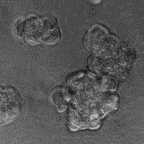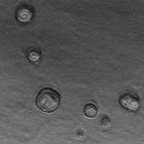![]()
Important New Findings Reported In Breast Cancer Study |
 |
| By Lynn Yarris, lcyarris@lbl.gov April 4, 1997 |
BERKELEY, CA -- In the fight against breast cancer, researchers should be looking at other factors in addition to oncogenes and tumor-suppressor genes. Scientists at the Ernest Orlando Lawrence Berkeley National Laboratory have shown that, in some cases, what is happening immediately outside of a cell -- its microenvironment -- can be equally if not more important than the presence of cancerous genes within.
In a recent proof-of-principle experiment, malignant human breast cells were made to look and act like normal cells both in tissue cultures and in mice through the manipulation of their microenvironment. Though this work offers no immediate promise of a cure, it does point to the possibility that breast cancer may in the future be treated or perhaps even prevented through means other than conventional genetic therapy.


Through manipulation of the microenvironment, the malignant human breast cells (left) have been made to look and act like normal cells (right).
The research was led by Mina Bissell, director of Berkeley Lab's Life Sciences Division, and Valerie Weaver, a post-doctoral scholar in cell and molecular biology. Other contributors included Fei Wang and Carolyn Larabell, of Berkeley Lab, Ole Petersen and Per Briand, of Denmark, and Carolyn Damsky, of the University of California at San Francisco. The results are reported in the April 7, 1997 issue of the Journal of Cell Biology.
"These findings have vital implications for breast cancer diagnosis and prognosis," says Bissell. "That cancer is the result of not just genetic change, not just developmental regulation, or loss of growth regulation, but an interweaving of all of these factors is an insight with practical significance and we are making important strides to reinforce this concept."
Breast cancer is the most common and lethal malignancy in U.S. women between the ages of 40 and 45. Each year approximately 182,000 American women develop the disease and each year approximately 46,000 die from it.
For the past two decades, Bissell has been an outspoken advocate of the importance of other factors besides conventional genetics in breast cancer's development and spread. Her theory holds that breast cancer arises from a breakdown in communication between a cell and its microenvironment, particularly the extracellular matrix (ECM) -- a network of fibrous and globular proteins that serves as support "scaffolding" for breast cells.
Bissell's theory was first described in January, 1982 when she posited that the ECM, through its signals to the nucleus, plays a vital role in controlling normal cell growth and development. By implication then, any alteration of the ECM (through loss or damage), or the way the cells responds to the ECM could lead to malignancy, which is essentially cell growth and development gone amok.
"I call this concept dynamic reciprocity," she says. "Signals from the ECM are shuttled into the cell where they establish a dialogue with the chromosomes and DNA which in turn affects the ECM. Our studies have not only confirmed this model but have revealed an unexpected role for the ECM in gene expression, that the ECM can trip switches deep within the nucleus and spur the genes themselves into action."
Research results at Berkeley Lab and elsewhere have garnered increased support for Bissell's theory. In the latest experiments, Weaver worked in Bissell's laboratory with unique lines of human mammary epithelial cells developed by Briand and Petersen, one that remains "normal," and one that becomes malignant following an identified series of steps. The malignant strain of these cells was treated in culture with an antibody that blocks one of the integrins -- proteins that reside in the outer membrane of a cell and through which signals from the ECM are transmitted inside.
Under the influence of the integrin-blocking antibody (it blocked an integrin called Beta-1), the malignant cells reverted back to a normal appearance and behaved as if they were healthy cells, i.e, their cancerous growth ceased. The same type of malignant cells treated with the same antibody and injected into mice yielded many fewer tumors that grew much more slowly than untreated cells.
"By altering the pathways between the ECM and the nucleus, we were able to revert malignant cells back into a form and function that was very similar although not identical to normal," says Weaver. "When you examine these reverted cells with a fluorescent probe you see that the genes in their nuclei are still abnormal. This indicates we changed the phenotype but not the genotype."
Weaver likens the experiment to transferring children with behavioral problems into an environment where they can succeed. In a different environment those same behavioral problems could resurface.
"We've shown that (as Bissell's theory predicted) there is a plasticity in the way that a cell behaves, depending upon the signals it receives from its microenvironment," she says. As further proof of this phenomenon, Weaver was also able to take normal cells, disrupt the performance of their integrins, and induce them to look and act like cancer cells.
"Our findings suggest that maybe a window exists for alternative therapies," she says. "Treatments that would change the way a cancerous cell interacts with the ECM and other components of its microenvironment (i.e., other cells) might even prevent the cancer process from being promoted."
The use of integrin-blocking antibodies, peptides, or other molecules, is one possibility, according to the Berkeley Lab researchers, but molecules would have to be found that only target cancer cells in the breast. Nonetheless, Bissell calls the results of this latest experiment a "hopeful" sign for breast cancer research.
"We've shown that even after the cancer genes have been expressed and lesions have formed, it may still be possible to reverse the process and restore the cells to normal appearance and function," says Bissell.
In the Journal of Cell Biology paper, it was also noted that the results of this study could help explain why breast cancer takes so long to develop even in women who are at high genetic risk. So long as cellular and tissue structure are maintained, tumor development can, according to Bissell and Weaver, be suppressed despite the presence of cancer-inducing genes. Over the course of four decades in a woman's life, the ebb and flow of hormones and other contributors to the cell's microenvironment take their toll. Eventually, through mechanisms not yet identified, the ECM is altered. This, in turn, alters the signals sent from the ECM into the cell's nucleus, triggering the onset of malignancy.
"We are in the process of studying a line of pre-malignant cells to determine whether or not there are integrin alterations (such as changes in the ratios of one or more forms of integrins to the others) that might foreshadow the structural changes that lead to cancer," says Weaver.
The Berkeley Lab is a U.S. Department of Energy national laboratory located in Berkeley, California. It conducts unclassified scientific research and is managed by the University of California.
Additional Background Information:
- Breast Cancer: The Battle Within (from the Berkeley Lab Research Review magazine)
- New England Journal of Medicine Breast Cancer Collection with full text of journal articles since 1992.
![]()